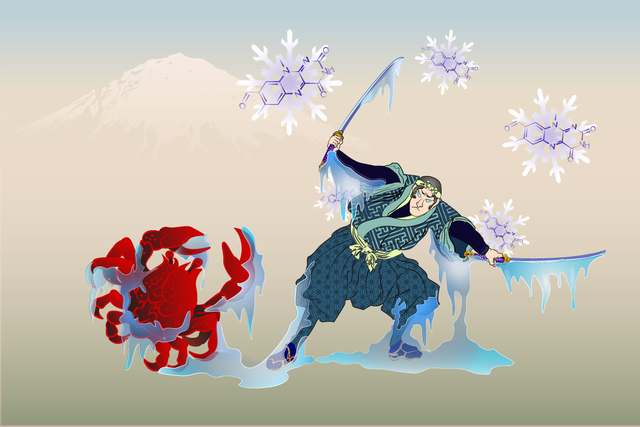
This illustration depicts the famous 17th-century samurai Miyamoto Musashi and a crab being frozen by the Ro compound. The warrior shares a name with the cancer-related Musashi protein, and crabs are often used to represent cancer, especially the Zodiac sign Cancer. Illustration by Olga Kharchenko
Since 2012, Memorial Sloan Kettering cancer biologist Michael Kharas has focused on studying a family of proteins called Musashi. These proteins play a role in acute myeloid leukemia (AML) as well as in many solid tumors, including colorectal, breast, lung, and pancreatic cancers. Musashi proteins function by binding to messenger RNAs. These molecules serve as a template for making proteins.
On June 19, 2019, in Nature Communications, Dr. Kharas’s team reported that they have identified a molecule that appears to block the function of Musashi-2. This protein plays a role in making cancer grow and spread. The compound appears to eliminate tumor cells in human cancer cell lines and in mice.
“This research provides a strategy for how to develop inhibitors for RNA-binding proteins,” says Dr. Kharas, who is in the Sloan Kettering Institute’s Molecular Pharmacology Program. “Historically, it’s been difficult to develop inhibitors to proteins that bind to RNA because of their challenging structural properties.
“We don’t think this particular compound will ultimately make it into clinical trials,” he adds, “but we now have a road map to guide us in future drug development.”
Turning Cancer Cells Back to Normal
This latest work builds on earlier research from Dr. Kharas’s lab, in which the investigators started with more than 150,000 molecules that could potentially block Musashi-2. They then developed a number of tests that could rapidly look for effective molecules in an automated way. Eventually, they settled on a molecule called Ro 08-2750, or just Ro for short.
In the current study, the team used structural biology to look at where Ro binds to Musashi-2. “Based on this research, we have an idea of where to start in designing additional molecules that could be used as drugs,” Dr. Kharas says. “We know the binding region and how the drug fits.”
Researchers know that Musashi-2 plays a role in how aggressive cancer is. The protein is present in more than 70% of people with AML. Solid tumors that contain a high level of the protein are more likely to grow, spread, and resist treatment. It appears that Musashi-2 allows cancer cells to continue growing and resist signals to die.
“Musashi-2 is required for cancer stem cells to survive,” Dr. Kharas explains. Cancer stem cells are cancer cells that have the ability to give rise to all types of cells within a tumor. “When Ro was added to AML cells in a dish, the cells became normal. They stopped growing and died.” The same effects were observed in mice that had AML.
A Cooperative Effort among Several Labs
This research was possible due to collaboration among many different experts at MSK. The project was overseen by Gerard Minuesa, a postdoctoral researcher in Dr. Kharas’s lab.
SKI computational chemist John Chodera, SKI structural biologist Dinshaw Patel, and Yehuda Goldgur, Head of MSK’s X-Ray Crystallography Core Facility, helped determine the structure of the Musashi-2 protein and how Ro binds to it. SKI computational biologist Christina Leslie helped with the gene expression data generated from this research.
“Thanks to this study, we’ve shown that it’s possible to develop drugs for these difficult targets,” Dr. Kharas concludes. “It provides a path forward for future work, so we can eventually develop drugs that can be tested in clinical trials in people with cancer.”






